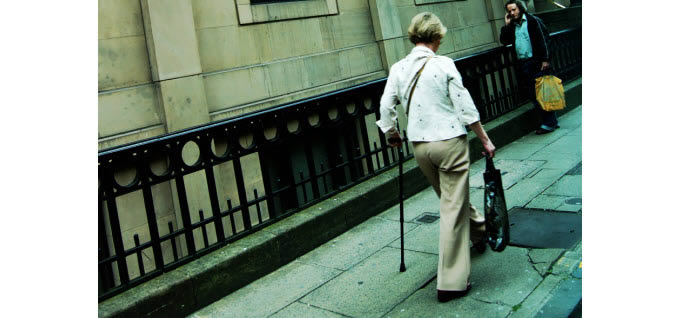Walking Cane Safety Step 1 – Fitting You for a Walking Cane
I Will Not Use a Walking Cane!
“Why not?” I asked, surprised by her tone. “Because canes are dangerous and I don’t want to look like an old lady.” “But you already are . . .” I hesitated to end my sentence with, “. . . an old lady,” so I said instead, “. . . walking with a limp.” After much discussion I agreed she had two very good points that were worth considering and she agreed to look at walking canes with me while holding an open mind about their safety and style.
Why Use a Cane and not a Walker
Sophia is 78 and has trouble with her left knee. A knee replacement had left that knee a little weaker than her right knee. As a result, she was unsteady when she walked and needed support for balance. Because she had good stamina and was in good health for her age, she didn’t need the full benefits of a walker. Her doctor had suggested she use a cane when she ventured outside. He had told her a walking cane would help her feel much steadier on her feet by taking a little weight off her weak leg and shifting it to a cane. This would allow her to continue to visit friends and neighbors and continue to do her volunteer work at the community center. So off we went to look at canes.
In this series of articles on how to choose and use a walking cane for safe mobility, we look at:
• Walking Cane Safety Step No. 1 – Fitting You for a Walking Cane
• Walking Cane Safety Step No. 2 – Choosing the Type of Walking Cane for Safe Support
• Walking Cane Safety Step No. 3 – Choosing the Safest Walking Cane Grip and Tips
Using a Cane Safely is First Priority
According to a Centers for Disease Control and Prevention study, published in the Journal of the American Geriatrics Society in 2009, an average of 129 American seniors per day were treated in hospital emergency rooms for injuries from falls that involved canes and walkers.
“Walking aids are very important in helping many older adults maintain their mobility. However, it′s important to make sure people use these devices safely,” said Judy Stevens, Ph.D., the study′s lead author.
Cane Safety Step No. 1 – Fitting your cane properly is as important as wearing good quality, properly fitting shoes.
Sophia and I learned how important it is to use a walking cane properly. So, before choosing or using a cane we did one of the most important things everyone should do first: we measured Sophia to determine the correct length of a cane for her personal use.
Fitting Your Cane – Use These Steps
1. Ask a friend or family member to help measure you for a cane. Having someone help you, allows you to stand straight while being measured, and this ensures you have an accurate measurement. A measurement out by as little as an inch can make a difference with your comfort and safety when using a cane.
2. Before measuring, put on the shoes you will wear while using your walking cane. Your walking shoes should have non-slip soles, be comfortable and in good condition.
3. Determine on which side you will use your cane. If you have weakness or an injury on your left side you will want to use your cane in your right hand. If your weakness or injury is on your right side, you will want to use your cane in your left hand. Take into consideration whether you have arthritis in one hand or wrist or if one hand is weaker than the other. If you do not have a weaker side, consider using your walking cane in your left hand (if you are right handed) to leave your right hand available for actions where you would most likely use your dominant hand. If you are in doubt which hand to use to walk with your cane, ask your doctor or physiotherapist.
4. When you know which hand you will use, stand up straight but in a relaxed position on a hard surface rather than a carpet. Hold your arms loosely by your sides. Bend your arm (the arm that will hold the cane) at the elbow approximately 30 degrees. If this is your right arm then from the side this bend will look like you are pointing your hand to 5 o’clock, if your shoulder is 12 o’clock and the floor is 6 o’clock. If this is your left arm then from the side this bend will look like you are pointing your hand to 7 o’clock, if your shoulder is 12 o’clock and the floor is 6 o’clock. This is a comfortable bend for distributing weight to your forearm and wrist when using your walking cane.

5. Measure from the floor to the wrist of the arm that is bent slightly. Measure the wrist at the point where it joins your arm on the under side. This point on your wrist is the height at which your cane handle will meet your hand. The measurement from the floor to the underside of your wrist tells you how long (or tall) your cane should be for best fist.
6. If you do not have a friend or family member to help you measure for a cane, try this: Stand straight next to a wall with the hand in which you will carry your cane next to the wall.  Hold your arm with a 30 degree bend at the elbow and hold a pencil in your lightly clenched fist next to the wall. Lightly mark the wall at your wrist level. This is similar to measuring the height of a child while holding the pencil straight on the child’s head.
Hold your arm with a 30 degree bend at the elbow and hold a pencil in your lightly clenched fist next to the wall. Lightly mark the wall at your wrist level. This is similar to measuring the height of a child while holding the pencil straight on the child’s head.
Once you have this measurement you will know how tall your cane should be including its handle. When we measured Sophia, this measurement was 34 inches. Performing this Safety Step first showed Sophia how important safety was when choosing and using a cane. It also inspired her to continue to look at walking canes as a logical, and safe, mobility aid for her.
Historical Document: June 29, 2009, emphasis mine. Content source: Office of the Associate Director for Communication,




 and get Cash rewards!
and get Cash rewards!